Fragmentology (manuscripts)
Fragmentology is the study of surviving fragments of manuscripts (mainly manuscripts from the Middle Ages and the Renaissance in the case of European manuscript cultures). A manuscript fragment may consist of whole or partial leaves, typically made of parchment, conjugate pairs or sometimes gatherings of a parchment book or codex, or parts of single-leaf documents such as notarial acts. They are commonly found in book bindings, especially printed books from the 15th to the 17th centuries, used in a variety of ways such as wrappers or covers for the book, as endpapers, or cut into pieces and used to reinforce the binding. In other non-Western manuscript cultures, fragments of paper manuscripts and other materials, takes place beside parchment, including board covers that many times reused written paper.
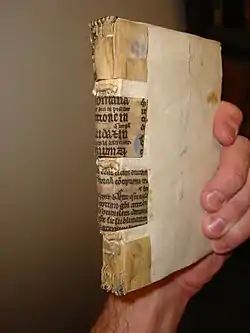
In recent years, fragmentology has become an active part of scholarly medieval studies fueled by the abundance in institutional libraries of binding fragments that have never been studied or even catalogued. A number of symposia, websites and projects have been formed to pursue the study. In their field-defining editorial, William Duba and Cristoph Flüeler note that fragmentology's "transdisciplinary nature requires the collaboration of specialists trained in a range of fields, not just paleography, codicology, and diplomatics, but also the history of the printed book, the history of libraries, musicology, art history, intellectual history, digital humanities -- in sum, most historical arts dealing with content on a page."[1]
Fragments used in bookbindings
Leaves and parts of parchment leaves have been used in bindings of manuscripts since the Middle Ages. The use of manuscript fragments in bindings increased greatly at the end of the 15th century when printed books began to appear in increasing numbers, supplanting many older manuscripts.[2] The conversion of northern Europe to Protestantism and the closing of monasteries and convents resulted in the discarding of many Catholic religious and liturgical manuscripts some of which were used by bookbinders.[2] Sometimes, manuscript fragments have been removed from bookbindings either because the fragments were viewed as significant or valuable, or in the course of rebinding. Removal of these fragments destroys important context and evidence and is strongly criticized by scholars. Where it is necessary to remove such fragments, accepted practice requires they be preserved with the book and their original location recorded.
Evidentiary value of fragments
Manuscript fragments may provide a variety of useful evidence for medievalists, bibliographers and paleographers, including:
- Preservation of a unique or rare text or other writing.
- Preservation of early or significant script.
- Evidence where a book was bound. Since medieval manuscripts generally did not travel far from where they were produced, the fact that a binding incorporates fragments of a manuscript from a known location may be evidence that the book was bound there or nearby.[3]
- Evidence concerning the book binder. The fact that fragments of the same manuscript are found in various bookbindings may connect the bindings, perhaps to a specific binder.[4]
- Evidence of ownership or provenance.
- The internal and external structure of the bookbinding.
Modern breaking of manuscripts
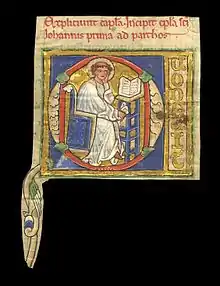
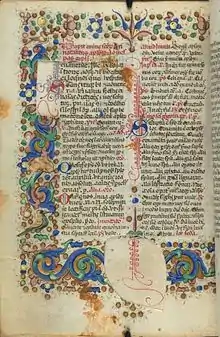
Beginning in the nineteenth century, collectors cut ornamented initial letters and miniatures from illuminated manuscripts. In the twentieth century some book dealers began removing leaves from manuscripts to be sold for greater profit as individual pages or keepsakes.[5] This "breaking" of manuscripts has been most common with books of hours which contain illuminated pages, gilding and attractive decorations. "As a result, today there are tens of thousands of single leaves in several hundred U.S. collections."[5] This practice continues today and many individual leaves of books of hours and antiphonals are available on eBay and from book and manuscript dealers.[6] Scholars strongly condemn this practice, even where the manuscript is incomplete to begin with, as it destroys the integrity and evidence of the entire manuscript. The most famous or infamous manuscript breaker was Otto Ege, who dismembered many complete and fragmentary manuscripts to sell the leaves individually or in large boxed collections.
Digital fragmentology
Scholars have studied Otto Ege's dismemberment and sale of manuscript leaves and have attempted to locate the present locations of the leaves of some of those manuscripts. A number of online projects have been started to collect images of these and other manuscript leaves in a virtual reconstruction of the original manuscripts, including Fragmentarium, based in Switzerland. This has been referred to as "digital fragmentology."[5] Websites have also been used to identify and date manuscript fragments through crowdsourcing.[7]
Gallery
 Manuscript leaf used as cover
Manuscript leaf used as cover Manuscript leaf used as pastedown
Manuscript leaf used as pastedown Manuscript leaf used as hinge reinforcement
Manuscript leaf used as hinge reinforcement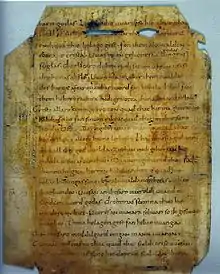 Manuscript leaf removed from book cover
Manuscript leaf removed from book cover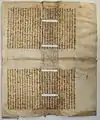 Book cover of manuscript leaf with slits for binding cords
Book cover of manuscript leaf with slits for binding cords
See also
- Codicology (the study of manuscript codices or books as physical objects)
- Paleography (the study of old handwriting and scripts)
- Otto Ege
- Binding waste (the sheets or fragments themselves)
Notes
- Duba and Flüeler (2018). "Fragments and Fragmentology". Fragmentology. 1: 1–5 – via fragmentology.ms.
- "Pickwoad, Nicholas (2000). "The Use of Fragments in Medieval Manuscripts in the Construction and Covering of Bindings on Printed Books". Interpreting and Collecting Fragments of Medieval Books (Proceedings of the Seminar in the History of the Book to 1500). Los Altos Hills, CA & London: Anderson-Lovelace & The Red Gull Press. pp. 1–20. ISBN 0-9626372-7-0."
- Katz, Farley, Rare French "Cisiojanus" fragment identified in bookbinding through crowdsourcing project, Cultural Compass, Harry Ransom Center.
- See Peter Kidd, Review: Fragments of Medieval Manuscripts Used as Pastedowns in Oxford Bindings, with a Survey of Oxford Binding c. 1515-1620, The Library: The Transactions of the Bibliographical Society, Vol. 7, No. 4 (December 2006), pp. 459-461.
- "Davis, Lisa Fagin (13 July 2015). "Manuscript Road Trip: The Promise of Digital Fragmentology". Retrieved 16 Jan 2017."
- Ben Mauk, "Scattered Leaves," The New Yorker (Jan. 6, 2014).
- Erwin, Micah, Archivist declares medieval manuscript fragment crowdsourcing project success, Harry Ransom Center.
Further reading
Symposia and studies
- Duba, William and Christoph Flüeler, "Fragments and Fragmentology" (editorial), Fragmentology 1 (2018), 1-5. DOI: 10.24446/a04a
- Brownrigg, Linda L.; Smith, Margaret M., eds. (2000), Interpreting and Collecting Fragments of Medieval Books (Proceedings of the Seminar in the History of the Book to 1500), Los Altos Hills, CA & London: Anderson-Lovelace & The Red Gull Press, ISBN 0-9626372-7-0
- "Manuscript "Fragmentology": Perspectives on the Scholarly and Pedagogical Value of Medieval Manuscript Fragments". 50th International Congress on Medieval Studies. 2015. Retrieved 26 January 2017.
- "Fragmentary Christian Texts of the Middle Ages: Contents, Methods, Challenges". The Fragment Project, University of Bergen. 2016. Retrieved 26 January 2017.
- Steyn, Carol (2016). "Fragmentology, the new manuscript study – with reference to manuscript fragments in South Africa". LitNet University Seminar.
- Widener, Michael (2010). "New exhibit, "Reused, Rebound, Recovered: Medieval Manuscript Fragments in Law Book Bindings"". Yale Law School Library. Retrieved 12 February 2017.
- Erwin, Micah (2012). "Medieval Fragments Project". Harry Ransom Center. Retrieved 12 February 2017.
- Mark Mersiowsky: Wenn Buchmenschen zum Messer greifen: Zur Wiederverwendung mittelalterlicher Bücher. In: www.flick-werk.net. Die Kunst des Flickens und Wiederverwertens im historischen Tirol, hg. v. Siegfried de Rachewiltz u. Andreas Rauchegger in Zusammenarbeit mit Christiane Ganner (Schriften des Landwirtschaftsmuseums Brunnenburg 15), Brunnenburg 2014, S. 200–219 .
- Perani, Mauro & Ruini, Cesarino (eds.), Fragmenta ne Pereant. Recupero e studio dei frammenti di manoscritti medievali e rinascimentali riutilizzati in legature, Longi Editore (Ravenna 2002). ISBN 88-8063-319-8
- Kienhorst, Hans, Verbruikt Verleden, Handschriftfragmenten in en uit boeken van klooster Soeterbeeck, Radboud Universiteit (Nijmegen 2009) ISBN 978 94 90128 19 7 With photographs of manuscript fragments in books at the Soeterbeeck Cloister.
Catalogs of manuscript fragments
- Babcock, Robert Gary; Davis, Lisa Fagin & Rusche, Philip G., Catalogue Of Medieval And Renaissance Manuscripts In The Beinecke Rare Book And Manuscript Library At Yale University: MSS 184 - 485 (Medieval and Renaissance Texts and Studies: V. 34, 48, 100, 176), Brepols Pub. (2004), ISBN 978-2503514406. Fragments in Beinecke Library.
- Gumbert, J. P., Illustrated Inventory of Medieval Manuscripts in Latin Script in the Netherlands, Introduction: Rules-Instructions, Hilversum, Netherlands (2009), ISBN 978-90-8704-110-6. Rules for describing manuscript fragments.
- Gumbert, J. P., Illustrated Inventory of Medieval Manuscripts in Latin Script in the Netherlands, Vol. 1 Utrecht, Museum Catharijneconvent, Hilversum, Netherlands (2011), ISBN 978-90-8704-261-5. (Illustrated)
- Gumbert, J. P., Illustrated Inventory of Medieval Manuscripts in Latin Script in the Netherlands, Vol. 2 Leiden, Universiteitsbibliotheek, Hilversum, Netherlands (2009), ISBN 978-90-8704-111-3. (Illustrated)
- Ferrari, Mirella, Medieval and Renaissance Manuscripts at the University of California, Los Angeles, University of California Press (1991), ISBN 0-520-09687-8, pp. 92–144. Collection of 134 medieval manuscript leaves.
- Ker, Neil R., Fragments of Medieval Manuscripts Used as Pastedowns in Oxford Bindings, with a Survey of Oxford Binding c. 1515-1620, Oxford Bibliographical Society Publications, Third Series, No. 4., Oxford: Oxford Bibliographical Society (1954), ISBN 0 901420 55 7.
- Skemer, Don C., Medieval & Renaissance Manuscripts in the Princeton University Library, Princeton (2013), Vol. II, Ms. 132, pp. 371–381, Taylor Collection of 89 Manuscript Leaves and Documents, Ms. 138, pp. 387–400, Princeton general collection of 133 Manuscript Leaves and Documents ISBN 978-0-691-15750-4.
External links
General
Digital fragmentology projects
- Fragmentarium-International Digital Research Lab for Medieval Manuscript Fragments
- Broken Books Project Center for Digital Humanities, College of Arts and Sciences at Saint Louis University
- Broken Books Project
- Manuscriptlink University of South Carolina
- Medieval Manuscript Fragment Project University College, London
- Lost Manuscripts Centre for Bibliographical History at the University of Essex
- Books within books: Hebrew Fragments in European Libraries
